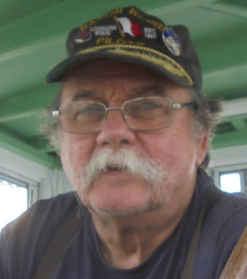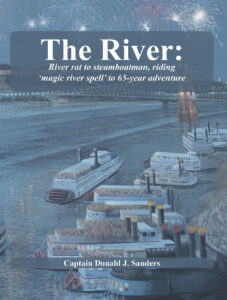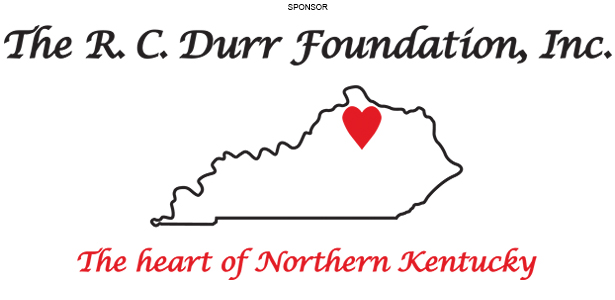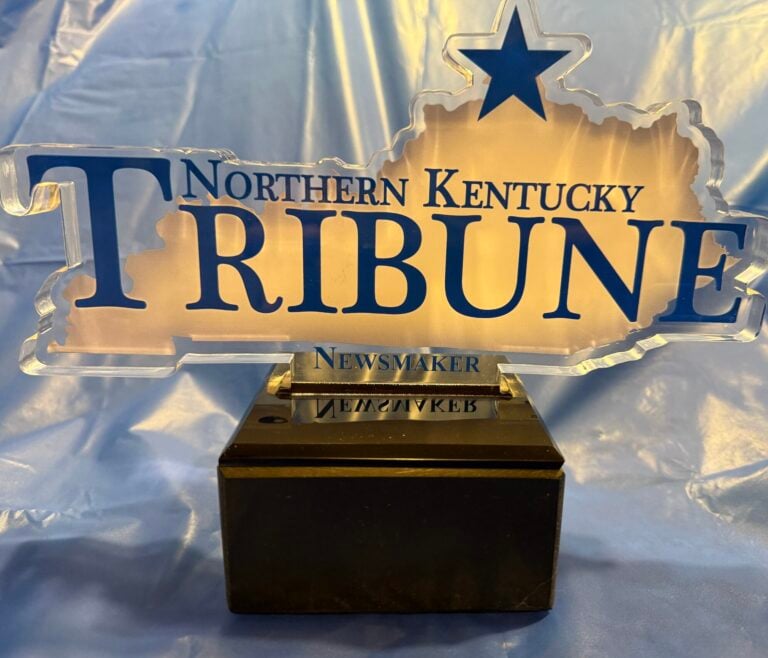The riverboat captain is a storyteller. Captain Don Sanders shares the stories of his long association with the river — from discovery to a way of love and life. This a part of a long and continuing story.
By Capt. Don Sanders
Special to NKyTribune
Following the intensity of the past two weeks’ columns announcing the plight of the DELTA QUEEN while reflecting on the throes and final rescue of the DELTA KING, I’m kicking back to chatter about less profound matters.

A few years ago, Popular Mechanics magazine, or one similar, featured the plans for a simply-built model of the DELTA QUEEN. With some fanagling, a clever builder could modify the plans to construct a tiny replica of the DELTA KING. The mag containing the plans gathered dust for several years until after Rick Starker applied for a deckhand’s slot on the GRAND VICTORIA II casino boat in Rising Sun, Mile 506 on the Middle Ohio River, across from Rabbit Hash, Kentucky. Starker, as we soon discovered, was a master wood butcher, capable of crafting just about anything made from deceased trees. Before long, Rick became the “Finisher” for the entire casino property, operating with an assistant named Leo from their exclusive floating studio on the GRAND VIC’s mooring barge.

Several miles downstream from Rising Sun, in the slightly smaller Hoosier town of Vevay, Rick Starker converted an ancient 1820s barn into a woodshop with a sign above the door identifying the structure as “Dream WoodWorks.” Inside, the barn contained the tools of Starker’s trade– a commercial tablesaw, plainer, joiner, and ample clusters of clamps with a sizeable storage room and loft for stacks of assorted lumber. After eight hours on the gambling boat payroll, Rick retired to his private Dream WoodWorks shop in the converted barn in Vevay, his hometown, and often worked late into the evening on custom orders.
Rick built several such orders at my request. All the wooden replacement parts for the paddlewheel of the sternwheeler Rafter CLYDE came from his Vevay woodshop. Starker replaced the decayed oak tow knees and the failed plywood sidedoors, amidships, with custom Eastern Red Cedar made from automatic conifers grown in Indiana. I cannot begin to count the numerous times my 1995 Ford F150 toted loads of native White Oak, milled to specifications, from Rick’s barn to CLYDE’s dock, below Aurora Bend, as replacement timbers in the sternwheeler’s one-ton “brushpile,” as old-timers often called a paddlewheel.

Heavily weathered bucketboards from CLYDE’s original paddlewheel transformed into idiosyncratic picture frames in Rick’s woodshop. A unique small brass cannon barrel, found in the yellow brass scrap box at a local recycling center, gained a guncarriage similar to those on long-ago sailing ships of war, and became CLYDE’s signal cannon until the sternwheeler sold.
During construction, the antique brass cannon mounted on his handmade oaken carriage became Rick’s pride and joy. After the CLYDE departed friendly waters for somewhere upstream of Suck Creek on the Tennesse River, I presented the master wood craftsman with the cannon and guncarriage. These days, CLYDE’s carronade reposes with honors at Rick’s Dream WoodWorks along with other masterpieces crafted by Mr. Starker’s hands.

According to my youngest son, Jonathan Evan Hartford Sanders, now the owner of the Starker-built, 30-inch, wooden model of the DELTA QUEEN, the heavy, solidly built replica is at least 19 years old. So old that when I reminded Rick that he was the builder, he could not recall building the scale-built replication until I refreshed his memory. As I mentioned earlier, the magazine with the illustrated instructions languished around the house collecting dust until I accidentally rediscovered it and asked Rick if he cared to build a copy. Happily, he agreed.
Although the DELTA QUEEN miniature measures just 30 X 41/2 X 9 inches, it is surprisingly heavy. This puppy contains no balsa wood. Rick used scrap lumber found around his shop to build the parts. The hull probably includes the same type of heavy White Oak used in CLYDE’s paddlewheel. When a weighting scale determines the scruffy miniature paddlewheeler’s overall burden, its weight will join the miniature’s list of proportions.
Once Starker fitted together the pieces of the model DELTA QUEEN, he artistically painted it to replicate the actual QUEEN by generously employing the signature color of the larger version of the overnight, passenger-carrying steamboat– Greene Line “greene.” In my early days aboard the DELTA QUEEN, as early as 1965, specially blended decorative and protective coatings arrived onboard specifying the color within the cans as greene paint.
My only contribution to Rick’s model was the addition of a “white collar” around the miniature smokestack. Technically, however, my addition of the white collar is incorrect for the time frame specified by the plans for the DELTA QUEEN, which portray the QUEEN before her makeover before the beginning of the 1971 season.

One Sunday, that Spring, during a lull of the QUEEN’s reconstruction at Avondale Shipyard in Covington, Louisiana, several miles above New Orleans, Engineer Kenny P. Howe, Jr. and I added a White Collar to the stack while Captain Ernest E. Wagner and Greene Line President William “Bill” Muster” were off the boat enjoying raw oysters and tall mugs of frosty draughts of Jax Beer at Felix’s Oyster Bar in the French Quarter.
By the time the company Volkswagen pulled into the shipyard, Kenny and I had just finished the final touches to the collar. Immediately, both Captain Wagner and Mr. Muster approved the decorative edition I envisioned as a tribute to Captain Frederick Laidley, of my hometown, Covington, Kentucky, who, in his time, owned and operated the “White Collar Line” of steamboats running between Cincinnati and Louisville. Mr. Muster, however, had a modification to add of his own. The next day, painters from the shipyard arrived with paint and brushes, transforming the White Collar into a glistening White Crown for the QUEEN of the Delta.
Whether the White Collar remains on the miniature DELTA QUEEN remains uncertain. After all, the model belongs to Jonathan, and the final decision remains his to make. One sure thing about the Starker model, however, is the agreement Rick and I just made while we talked on the phone only an hour earlier. We agreed to have him build a much-needed case for the miniature of the historic paddlewheeler now searching for new owners to SAVE THE DELTA QUEEN.
My most sincere steamboat hope, however, is that the full-sized DELTA QUEEN fares as well as the rugged miniature presently reposing in Jonathan Hartford Sanders’ “great big collection of steamboat stuff.” Oh, yeah…
 Captain Don Sanders is a river man. He has been a riverboat captain with the Delta Queen Steamboat Company and with Rising Star Casino. He learned to fly an airplane before he learned to drive a “machine” and became a captain in the USAF. He is an adventurer, a historian and a storyteller. Now, he is a columnist for the NKyTribune, sharing his stories of growing up in Covington and his stories of the river. Hang on for the ride — the river never looked so good.
Captain Don Sanders is a river man. He has been a riverboat captain with the Delta Queen Steamboat Company and with Rising Star Casino. He learned to fly an airplane before he learned to drive a “machine” and became a captain in the USAF. He is an adventurer, a historian and a storyteller. Now, he is a columnist for the NKyTribune, sharing his stories of growing up in Covington and his stories of the river. Hang on for the ride — the river never looked so good.
Purchase Captain Don Sanders’ The River book

Capt. Don Sanders The River: River Rat to steamboatman, riding ‘magic river spell’ to 65-year adventure is now available for $29.95 plus handling and applicable taxes. This beautiful, hardback, published by the Northern Kentucky Tribune, is 264-pages of riveting storytelling, replete with hundreds of pictures from Capt. Don’s collection — and reflects his meticulous journaling, unmatched storytelling, and his appreciation for detail. This historically significant book is perfect for the collections of every devotee of the river.
You may purchase your book by mail from the Northern Kentucky Tribune — or you may find the book for sale at all Roebling Books locations and at the Behringer Crawford Museum and the St. Elizabeth Healthcare gift shops.
Click here to order your Captain Don Sanders’ ‘The River’ now.




















